A recuperator is a device that is part of a ventilation system. It is necessary to supply fresh air to the room, which is the key to maintaining a comfortable environment. The editorial staff of the site "bestx.htgetrid.com/en/" offers you an overview of the best household recuperators for 2020.
Content
Recuperator - what is it?
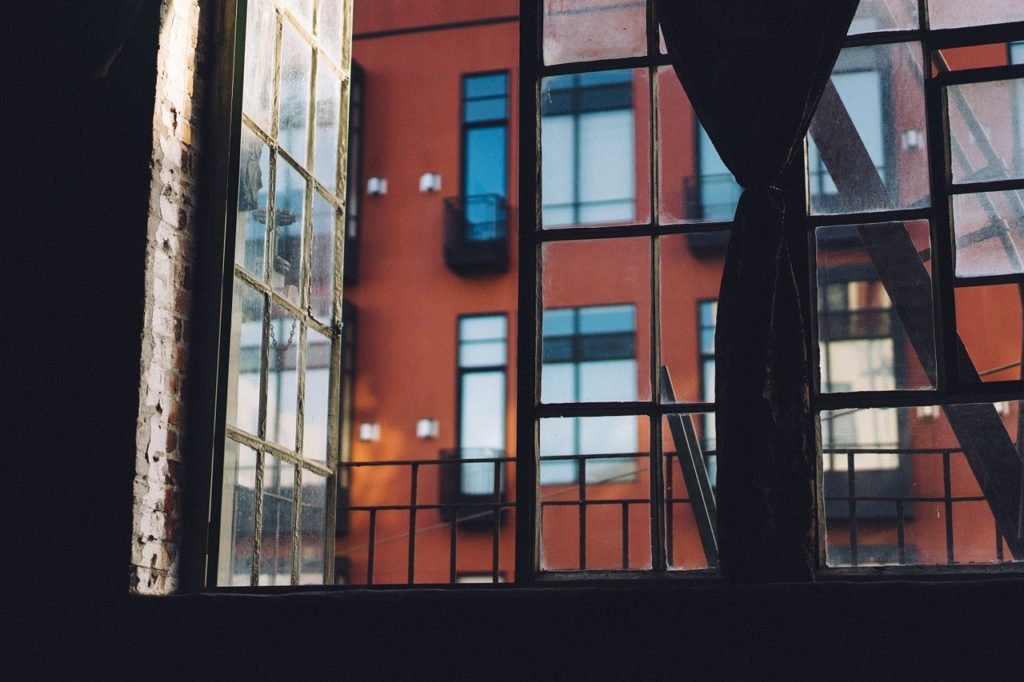
Any building, especially a domestic one, must have free access to clean outdoor air. And its volume should correspond to the volume of "exhaust" air removed from the room. Thus, there must be circulation. However, along with the air outflow, something very valuable goes away. In winter it is warm, and in summer it is cool, diligently acquired by powerful energy-consuming air conditioners. It is in order to prevent this that the recuperator (or recuperator) was developed.
The word "recuperator" itself has Latin roots and comes from the word "recuperation", which can be translated as "receiving", "returning". In this case, we can talk about this device as a heat exchanger, which prevents heat losses in the cold season, and prevents the heat from entering the house along with a new air flow during the hot season. As a result, in an air-conditioned system, the recuperator provides a favorable microclimate without high electricity costs.
Operating principle
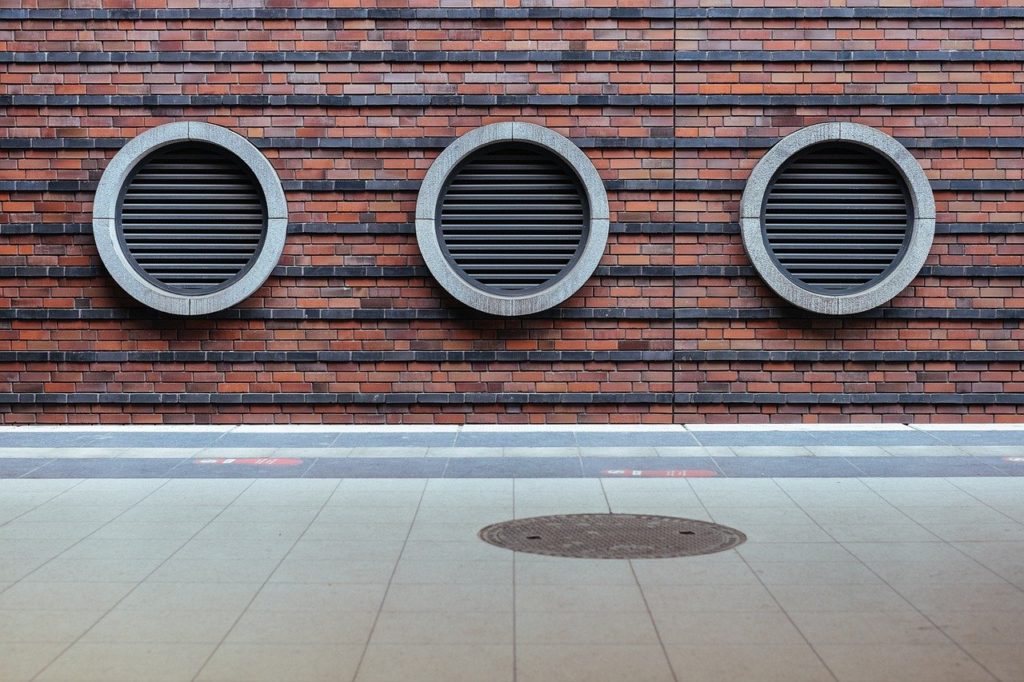
The heat recovery method is an energy saving technology that allows you to reduce heat losses attributable to ventilation. The recuperator makes it possible to save up to 70% of the heat “leaving” to the street and reuse it.
The recuperator operation scheme is quite simple. In fact, the device is a double-walled heat exchanger, where two air streams meet without mixing with each other - supply and exhaust. Due to the fact that the flows have different temperature indicators, when they meet between them, an exchange of thermal energy occurs. Simply put, a cold stream heats up, and a warm stream cools. Also, during the cooling of the warm stream, moisture is removed from the air. In the form of condensate, it settles on the walls of the heat exchanger or returns back to the room.
What are they?
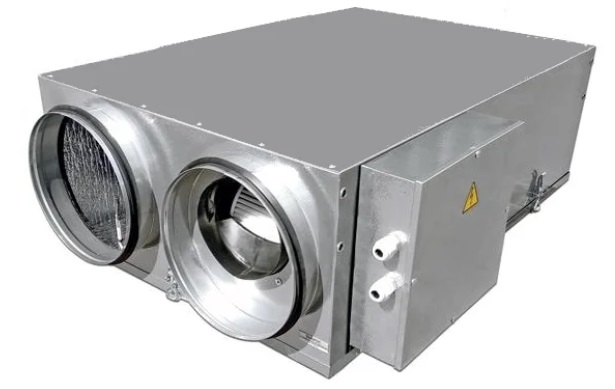
The units are divided into the following types:
- By design type - shell-and-tube, spiral, rotary, lamellar, lamellar finned.
- By appointment - air, gas, liquid. Air is understood as a ventilation unit, the task of which is ventilation with heat recovery. In gas-type devices, smoke is used as a coolant. Liquid recuperators - spiral and battery - are often installed in swimming pools.
- According to the temperature of the coolant - high-temperature, medium-temperature, low-temperature. High-temperature recuperators are called high-temperature recuperators, the heat carriers of which reach 6000 C and higher. Medium-temperature devices are devices with coolant characteristics in the region of 300-6000C. The temperature of the coolant of the low-temperature unit is below 3000FROM.
- By the way of movement of media - direct-flow, counter-flow, cross-flow. They differ depending on the air flow direction pattern. In cross-flow units, the flows follow perpendicular to each other, in counter-flow units, the inflow and exhaust are opposite to each other, and in direct-flow units, the flows are unidirectional and parallel.
Shell and tube recuperators
They have the simplest device. Disadvantages - weight, dimensions, difficulty in maintenance.
Spiral
In spiral models, heat exchangers look like two spiral channels through which media move. Made of roll material, they are wrapped around a centrally located dividing wall.
Rotary recuperators
Installed in supply and exhaust ventilation systems. Their mode of action is based on the passage of the supply and exhaust flows through a special rotary rotary heat exchanger.
Plate heat exchanger
It is a recuperator, where the transfer of heat from a hot medium to a cold one occurs by passing through steel, graphite, titanium and copper plates.
Finned plate recuperator
Its design is based on thin-walled panels with ribbed surface, produced using high-frequency welding and connected to each other in turn with a turn of 900... Such a design, as well as a variety of materials used, allows achieving a high temperature of the heating medium, minimum resistance, long service life, high rates of heat transfer area in relation to the total mass of the heat exchanger. In addition, such devices are inexpensive and are most often used for processing the heat of waste gas media.
The popularity of finned models is based on the following advantages (in comparison with analogues of the rotary and traditionally plastic type):
- high operating temperatures (up to 12500FROM);
- small weight and size;
- more budgetary;
- fast payback;
- low resistance along gas-air paths;
- resistance to slagging;
- easy cleaning of channels from contamination;
- long service life;
- simplified installation and transportation;
- high rates of thermoplasticity.
Industrial and household recuperators - what are the differences?
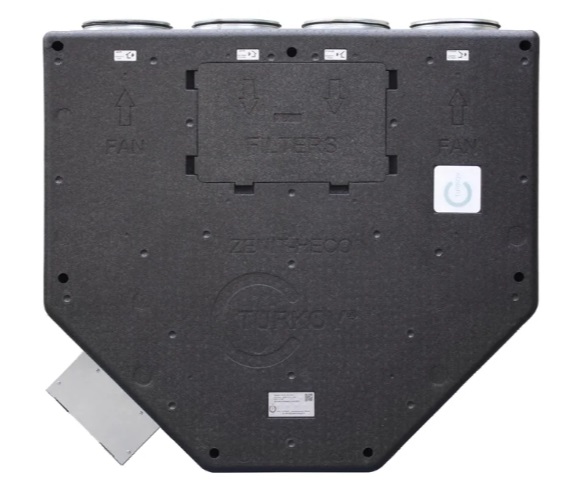
Industrial units are used in industries where thermal technological processes are present. Most often, industrial means precisely traditional plate heat exchangers.
Household installations include devices characterized by small dimensions and low performance. These can be supply and exhaust models, the main task of which is reduced to ventilation with heat recovery. Such systems can be implemented in different ways - both in the form of a rotary and in the form of a plate heat exchanger. Moreover, each of them has its own advantages and disadvantages.
Next, we will consider the main selection criteria in order to understand which recooler is better to buy.
How to choose?
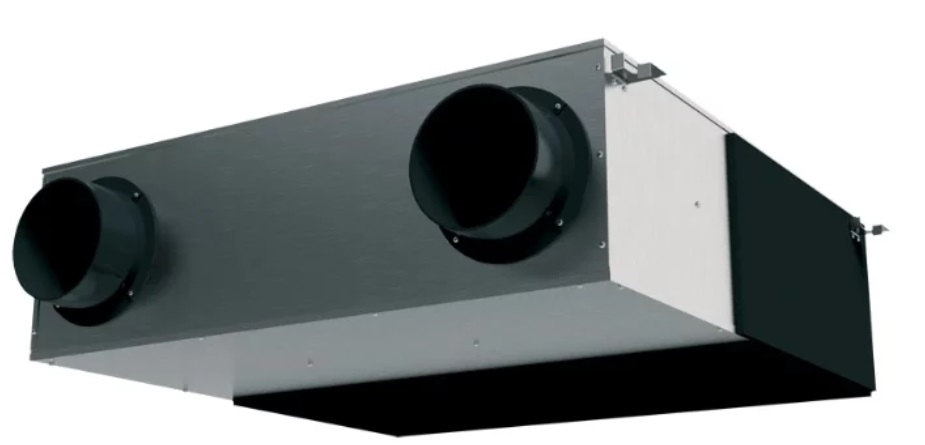
When choosing a household device, you should pay attention to the following parameters:
- Material;
- Functional;
- Room type;
- Performance and microclimate conditions;
- Installation method.
Material
The heat exchanger can be:
- Ceramic. Of the advantages - it effectively accumulates and gives off heat for a long time, does not fear moisture. And thanks to the honeycomb structure, the area of the heat-conducting material is as wide as possible. Of the minuses - it heats up for a long time.
- Copper / aluminum. The material is inexpensive and conducts heat well. The exhaust air gives off thermal energy to the plates, which in turn heat up the fresh supply stream.
- Plastic. Plastic has been used quite recently, and therefore it is still difficult to form a complete picture of it. Experts call such devices experimental and of the advantages they note so far only the price;
- cellulosic. Able to function in conditions of medium and low humidity, maintaining its optimal level. From the pros: does not dry out.Of the minuses: sensitive to moisture and low temperatures - freezes at -50FROM.
Functional
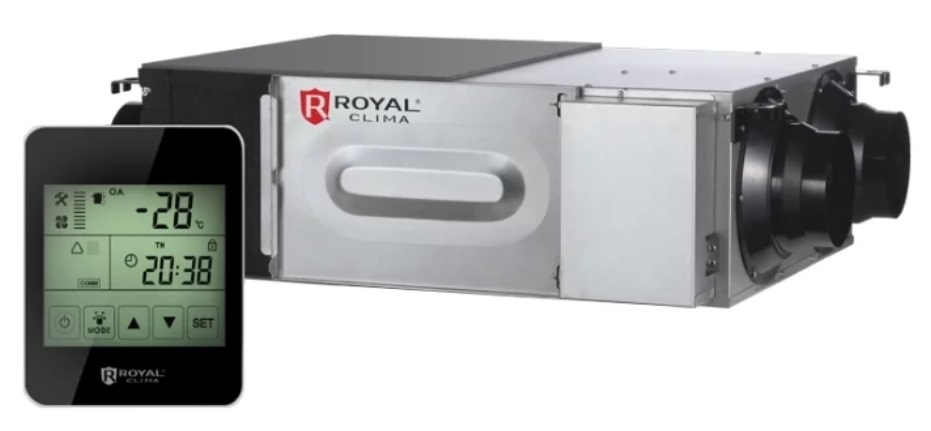
Some models may have the following functions:
- Highly efficient multi-level filtration system;
- Heating of the supply stream;
- Step regulation of fan speed indicators;
- Heat recovery up to 94-97%;
- Control and monitoring of air quality by various sensors;
- Operation in the "night" mode, which protects against noise;
- Work in automatic mode;
- Control via PC, smartphone, tablet, remote control.
Room type
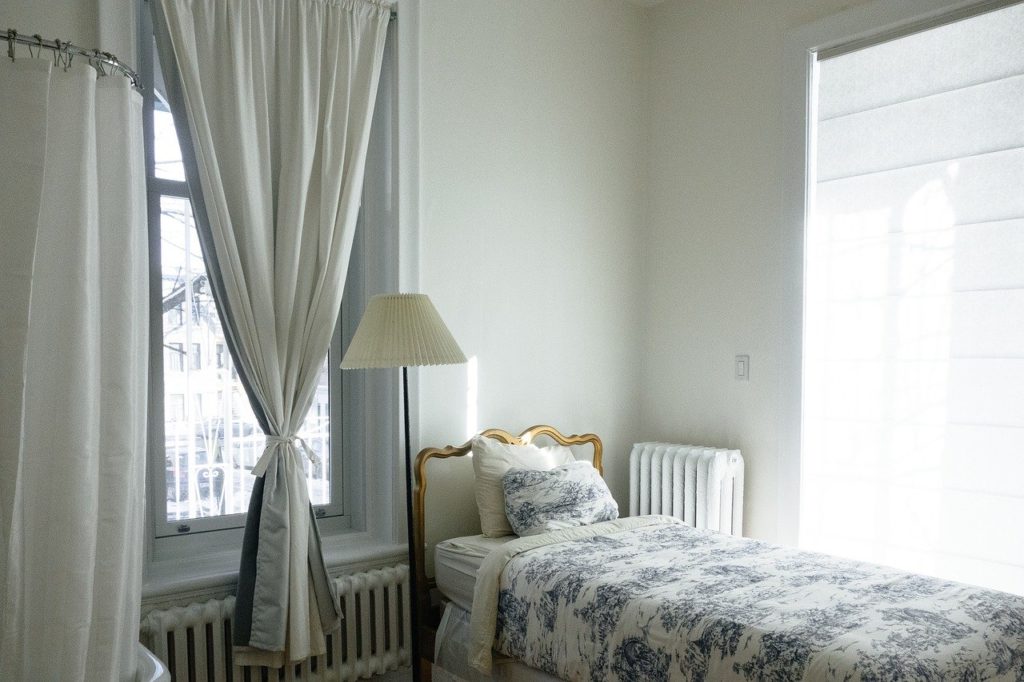
Installation of ventilation should be carried out taking into account air exchange rates, which differ depending on the type and purpose of the room. So, for bedrooms and living rooms, it is recommended to organize an air flow. And for bathrooms, lavatories and kitchens, the equipment that produces the hood is best suited. This is necessary in order to prevent the passage of polluted air into living rooms.
Offices are characterized by the problem of excessive heat generation from equipment and a large number of employees. In gyms, in addition to the large amount of heat due to the active interaction of visitors with the exercise equipment, there is also increased humidity. And there, and there, a more powerful unit is required than for a house.
When installing equipment in classrooms and kindergarten rooms, several important factors must be taken into account at the same time - the number of people, humidity and the amount of pollutants.
For a private house, wall-mounted plate units are most suitable. They are easy to install, do not require additional care and special maintenance, and do not spoil the interior. If it is planned to install powerful equipment, which implies large dimensions of the device, then it is better to provide for installation even during construction.
A plate model is also suitable for an apartment, but in order to avoid mistakes when choosing, one should take into account the fact that most of the recuperators, due to their impressive dimensions, are designed for thick external walls. And for an apartment you need a device that can withstand a wall in a panel house. A good option is a device based on reverse technology.
It is also important to consider the area that the recooler will have to maintain. It must match the capacity and bandwidth of the equipment. A too powerful device in a small area will be energy consuming and uneconomical. And insufficiently powerful in a large serviced area will not be effective enough and will not give the desired result.
Performance and microclimate conditions
The flow rate of the supply air volume in a residential building can be calculated in two ways - based on the area, as well as by the number of living (permanently) people.
Microclimate conditions in living and sleeping rooms can be:
- increased optimal (36 m3/ 1 person or 5 m3/ hour for 1 m2) - necessary for people with special needs, for example, people with disabilities, sick people, small children, elderly people;
- optimal (25 m3/ 1 person or 3.6 m3/ hour for 1 m2) - create a feeling of comfort due to the optimal ratio of freshness and warmth, contribute to an increase in efficiency and activity;
- permissible (15 m3/ 1 person or 2.2 m3/ hour for 1 m2) - force a person to use additional thermoregulatory mechanisms for physiological adaptation, but at the same time do not cause irreversible or dangerous consequences for health.
Also important is the CO indicator2... Carbon dioxide (also known as carbon dioxide) is emitted by humans at a rate of approximately 20-25 liters per hour. When people are constantly in the room, the CO level2 increases, the amount of organic matter and bacteria also increases. The latter is quite simply determined by the smell - the air becomes stale, heavy. At CO concentration2 above ten percent, the person loses consciousness.
At the same time, according to European regulations, optimal conditions are created when the room receives from 12 to 25 m3 fresh air hour per person. Thus, the capacity of the unit is 120 m3/ hour will be enough to meet the needs of 3-4 people in the room at the same time.
Installation method
Possible floor, hanging and roof.
Ceiling-mounted options are interesting in that they allow you to hide all technical details in the cavity of stretch and suspended ceilings. The price of such devices is quite high and is determined by the requirements for the dimensions of the device - it must be compact. At the same time, for its connection, auxiliary bypass channels are not required. A significant disadvantage of this method is noise during operation, which is caused by the small distance between the functioning parts and ventilation grilles.
Floor-standing and wall-mounted appliances are focused on placement in technical rooms. The performance of such models is not limited by dimensions, however, it is important to correctly make the strapping system. Floor / wall-mounted devices are used in conjunction with air conditioning and heating systems.
Rooftop models are frequent guests in buildings with one large room. They are installed on the roof of the building and have such advantages as high level of efficiency, quick and easy installation, and easy maintenance.
There are also point wall models that are mounted separately in each room adjacent to the street. They are good because they do not need additional communications.
Tips for choosing
Regarding the equipment operation scheme:
- a recuperator with the functionality of a ventilator can only be installed on the supply of fresh outside air, and the exhaust air will be removed naturally through the hood;
- a counter-flow device, simultaneously operating for inflow and removal, is capable of providing full ventilation to a separate room;
- devices with additional connection of air ducts are aimed at simultaneously servicing several rooms or an entire apartment at once through one installation;
- units operating in reverse mode are recommended to be installed in pairs. This eliminates the violation of the air balance in the apartment or house;
The considered operating schemes are basic, however, it is best to discuss the specific scheme and the choice of the number of devices with specialists.
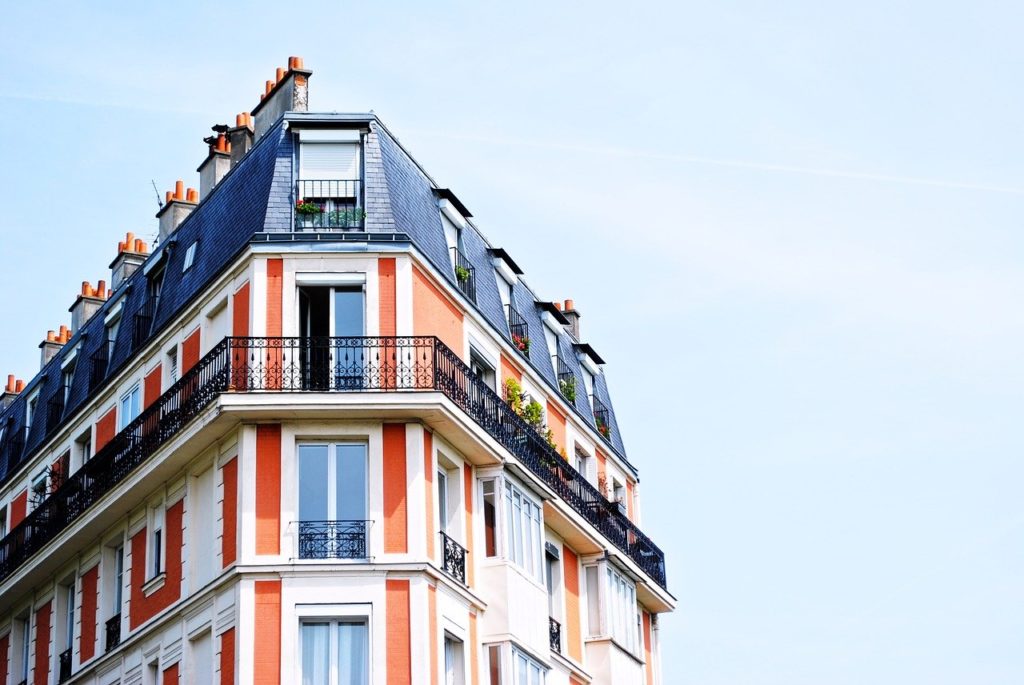
About the number of storeys in the building:
- Due to possible strong gusts of wind, recuperators are not advised to install them in apartments above the fifth floor, especially if the installation site is not protected. Strong winds can negatively affect the heat exchange characteristics and the functioning of the fans. Also, due to the height of the floor, a weaker natural draft should be considered.
- A compact air handling unit with a heating and cleaning function is suitable for the upper floors. Supply and exhaust ventilation can also be used - for a separate room or apartment.
It will also not be superfluous to take into account the layout of the house / apartment - are there doors between rooms and gaps under the doors for overflow, walk-through rooms or not, is there free air access from living rooms to the kitchen and bathroom.
Which company is better?
The best manufacturers of climatic equipment are:
- Breezart;
- Turkov;
- Blauberg;
- Royal Clima;
- GlobalVent;
- Soler & Palau;
- VAILLANT.
Popular models are produced by Maico (Germany), PRANA (Ukraine), VAILLANT (Germany), TION (Russia), MITSUBISHI ELECTRIC (Japan), VENTS VENTS (Ukraine).
Where to buy and how much does it cost?
In terms of price, the devices vary depending on the brand and the performance of the entire ventilation system. In order to determine the price, it is necessary to develop a competent project that will meet specific requests and conditions. Not only the effective operation of the entire system depends on the quality of the project, but also the amount of further maintenance costs.According to buyers, the equipment can be selected independently, and this is really so - air ducts, grilles and other elements are available for purchase, but it is best for a professional to deal with these issues. The designer will have to pay extra, and at first glance, such costs seem impressive, but in the future this will avoid many possible problems and unforeseen costs during repairs.
When choosing a recuperator, first of all, you should evaluate the price / quality ratio. You should not immediately grab onto new items or overpay a significant amount only for a promoted brand. After all, the equipment is not cheap and will pay off for several years.
You can purchase the device by visiting a specialized store or ordering online from the online store. But regardless of the chosen place of purchase, you should definitely study the description of the product and reviews, as well as check for product certificates and find out how long the warranty is. As a rule, it is given not for the device itself as a whole, but for its individual components. Therefore, the higher the quality of the components, the more expensive the equipment will be.
Advantages and disadvantages
Advantages of recuperators:
- Regular cleaning from harmful substances - dust, small pollution, exhaust gases, allergens and other possible emissions, typical for megalopolises and cities with a large number of industrial enterprises;
- Organization of high-quality ventilation of the room without dangerous drafts;
- Significant savings on heating, which is obvious primarily to people living in private houses;
- For apartment buildings with a central heating system, thermal savings are not so relevant, but there is an acute problem with ventilation and fresh air;
- Where the unit is installed, cleaning should be carried out 2-3 times less often.
Disadvantages:
- Plate models in winter prone to frosting, which requires periodic shutdown of equipment or more expensive equipment;
- Moving parts of the structure (especially in rotary models) require periodic maintenance;
- A tangible value that can pay off in just a few years.
Main technical characteristics
| room | Specifications | Recommendations |
|---|---|---|
| 1 | Control system | In the simplest version, the recuperator does not have a control system, but at the same time it is equipped with a damper that allows you to adjust the heat exchanger throughput. In other cases, the recuperator is the only element for enforcing the flow, therefore, the speed of its fans determines the intensity of air exchange. For such units, manual mode switching is provided. There are also models whose operation is controlled by a remote control. The most advanced models can be connected to a general home automation system and automatically adjust performance based on data on the number of people or information obtained from indoor gas analyzers. |
| 2 | Heat accumulators | The weak side of many household recuperators is the icing of the heat exchanger during the cold season. To prevent this from happening, the best models are equipped with heat accumulators, as well as increased strength fans. |
| 3 | Filters | The devices are equipped with filters to clean the incoming air from contamination. As a rule, different filters are installed on the incoming and outgoing streams - fine and coarse filters. |
| 4 | Noise level | Recuperators are quite noisy equipment, and therefore tend to be installed in utility rooms. When choosing a device that is planned to be installed in living rooms, it is important to pay attention to the noise level. |
| 5 | Lifetime | The operational life of the equipment is approximately 10 years, the warranty period varies within 3 years - depending on the manufacturer. |
| 6 | Additional modes | Additional functions that may be present in recuperators include night mode, CO2 sensor operation and the ability to connect to the "smart home" system. |
| 7 | Mounting | Provides for the installation of the device at a certain slope on an external wall of a certain thickness (from 300 to 600 mm). A channel is punctured in the wall and thermal insulation around the body is required, as well as sealing of gaps in the wall. You must first de-energize the room so that you can lay the electrical wiring to the control panel. Wireless models only need a power outlet to connect the power to the recuperator. In the absence of special skills, it is best to involve specialists in the installation. |
Rating of quality models for 2020
Lamellar
Mitsubishi Electric Lossnay VL-100EU5-E
Manufacturer: Mitsubishi Electric (Japan)
Pipe diameter: 75 mm
Dimensions (w / h / d): 62x16.8x26.5 cm
Weight - 6.5 kg
Average price - 29,000 rubles.
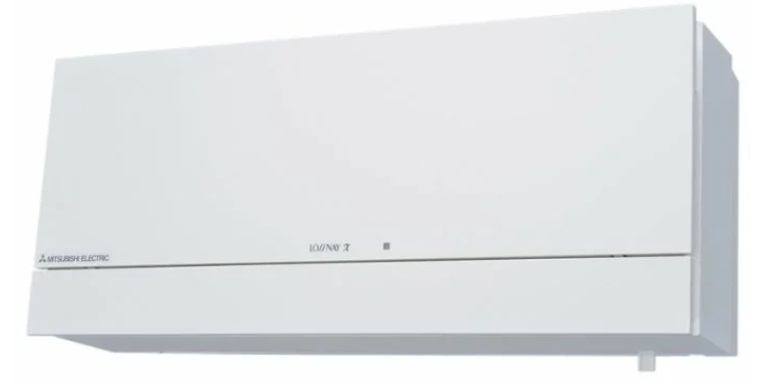
Suspended air handling unit with plate recuperator. Can be mounted both vertically and horizontally. Air exchange parameters: minimum - 65 m3/ hour, maximum - 105 m3/hour. The noise level is 30 dB. The recuperator is made of thin paper impregnated with a special composition. It adjusts not only the supply air temperature, but also the humidity. The installed filters help to clean the air from large fractions of dirt and dust. The body of the device is designed to absorb sound vibrations.
Advantages:
- quiet work;
- aesthetic appearance;
- easy installation;
- ease of maintenance;
- affordable price;
- with a coarse filter for inlet and outlet;
- with temperature sensors;
- quickly eliminates foreign odor.
Disadvantages:
- lack of a control panel;
- stops work at low temperatures (below -100FROM).
Royal Clima SOFFIO RCS 950 2.0
Manufacturer: Royal Clima (Italy)
Pipe diameter: 200 mm
Dimensions (w / h / d): 96x27x96.2 cm
Weight - 43 kg
Average price - 75,000 rubles.
Hanging type ventilation brand device equipped with a plate recuperator. The unit is able to operate efficiently at low temperatures, is equipped with an intelligent bypass system, and the built-in fans have three speed modes. It does not need condensate drainage due to the use of membrane technology, that is, not only heat is transferred, but also moisture. The body is equipped with thermal insulation both inside and outside. The recuperation efficiency is 90%. Air exchange volume from 613 to 950 m3/hour. Power consumption - 0.23 kW. The noise level during operation is 31 dB.
Advantages:
- with temperature sensor;
- with a remote control with a touchscreen display;
- with frost protection;
- with a multilevel timer for a week;
- there is the possibility of connecting an additional carbon dioxide sensor;
- with the ability to connect an electric heater and a fan;
- there are built-in reusable filters;
- works quietly.
Disadvantages:
- price.
Rotary
Systemair SAVE VSR 300
Manufacturer: Systemair (Sweden)
Type: electric
Dimensions (w / h / d): 59.5x50.5x112.0 cm
Diameter - 160 mm
Weight - 65 kg
Average price - 204,000 rubles.
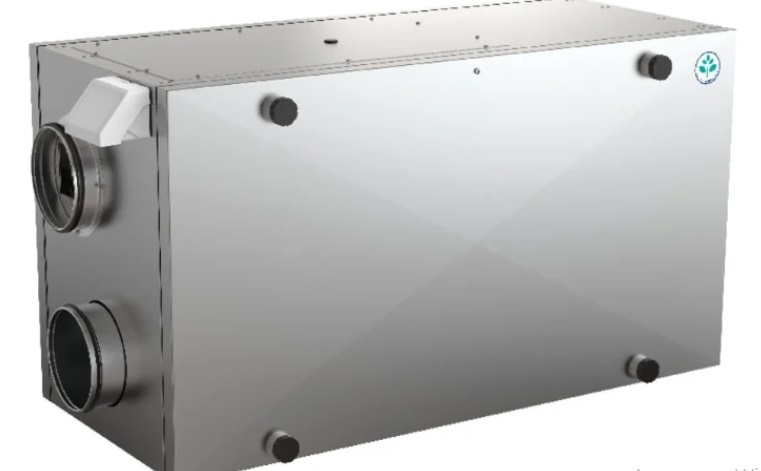
Supply and exhaust highly efficient suspended unit with a rotary recuperator. Suitable for residential buildings with service areas up to 240 m22... Air exchange volume - up to 376 m3/hour. The power consumption is 1.83 kW. The noise level is 42 dB. The distinctive characteristics of the equipment include a heat and sound insulated housing, a built-in programmed automatic system, a heat exchanger with the function of transferring moisture to the supply and high-quality fans that consume 50% less energy. The Wizard software will greatly simplify the first start-up, help you put the equipment into operation and prevent the use of incorrect settings. All set parameters are shown on the display. The device can be mounted vertically on the floor or horizontally under the ceiling.
Advantages:
- with a fine filter for the supply;
- with a coarse filter for the hood;
- with humidity and temperature sensors;
- with remote control and control panel;
- separate adjustment of inflow and outflow;
- frost protection;
- timer for changing modes from "day" to "night";
- danger alarm;
- external sensors can be connected.
Disadvantages:
- heavy;
- expensive.
GlobalVent Climate-R300
Manufacturer: GlobalVent (Russia)
Diameter of connected pipes: 160 mm
Dimensions (w / h / d): 60.5x25x88 cm
Weight - 27 kg
Average price - 105,000 rubles.
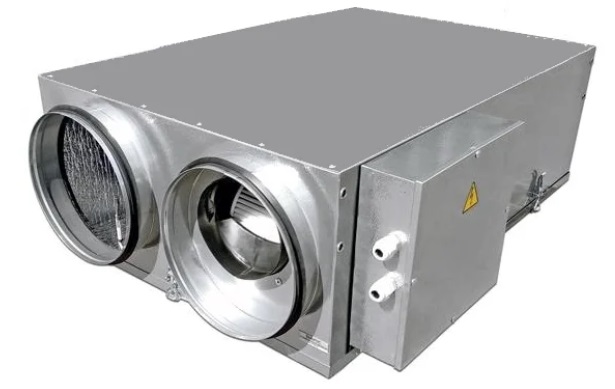
Economical and compact Russian-made ventilation unit with a rotary recuperator, which is used to maintain an optimal microclimate. In winter, the device provides heating of the supplied outdoor air, and in summer - cooling. Has a high level of performance (180-330 m3/ hour) with low electricity consumption (0.35 kW). Can be mounted either under a false ceiling or in a separate niche. This helps to keep the unit out of sight and hide all technical elements. The casing has thermal insulation characteristics and is made of galvanized steel. The produced noise level is 47 dB.
Advantages:
- self-cleaning unit;
- precisely adheres to the set temperature;
- simple and quick installation;
- installation in any convenient position;
- with temperature sensors;
- automatic control / control of the remote control;
- low power consumption;
- reliable work.
Disadvantages:
- expensive.
With intermediate insulation
Breezart 3700 Aqua RR
Manufacturer: Breezart (Russia)
Dimensions of rectangular pipes: 600x300 mm
Dimensions (w / h / d): 104x120.1x249.3 cm
Weight - 270 kg
Average price - 813,000 rubles.
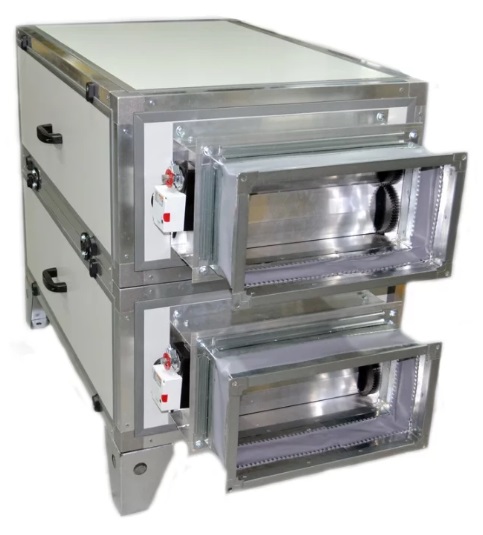
Air handling unit of the latest generation with a rotary recuperator and an intermediate heat carrier. There is a water heater and mixing unit with 2/3-way valve (depending on the type of water supply). Equipped with motorized air valves, digital automatic system with touch control panel and all necessary sensors. The fan operation is characterized by the presence of 10 speed steps, and therefore it can be adjusted based on the needs. It is also possible to control the humidifier and monitor the degree of contamination of the air filter. The equipment assumes horizontal floor mounting. The body is heat and sound insulated. Air exchange volume is up to 3700 m3/hour. Power consumption up to 1.4 kW. The achieved noise level is 49 dB.
Advantages:
- great productivity;
- powerful electronic automation system;
- with coarse filters for supply and exhaust;
- with temperature sensor;
- with remote control;
- with frostbite protection;
- with real time clock;
- 8 weekly scenarios of functioning, including modes "Comfort" and "Restart";
- can be connected to the “Smart Home” system;
- remote control from a computer or smartphone.
Disadvantages:
- noisy;
- heavy;
- expensive.
Blauberg KOMFORT Roto EC LW1000-2 S17
Manufacturer: Blauberg (Germany)
Dimensions (h / w / d): 70x121x74.5 cm
Weight - 130 kg
Average price - 313,000 rubles.
Air handling unit with rotary recuperator, water heater and electronic control. Design features allow the device to be mounted on the floor, suspended from the ceiling, or attached to the wall using special brackets. The device will help organize effective ventilation in an apartment, house, cottage. The casing is made of three-layer aluminum-zinc-coated panels with heat and sound insulation. A high degree of purification is achieved by a cassette filter on the exhaust and a pocket filter on the supply. The built-in heater is activated when the heat from the exhaust flow is insufficient to heat the supply air to the set temperature. The heater power is automatically controlled. Air exchange volume is 900 m3/hour. The achieved noise level is 58 dB.
Advantages:
- high efficiency (98%);
- pleasant appearance;
- with supply flow control;
- filters with indication;
- low power consumption;
- good protection class;
- alarm indication;
- timer operation;
- selection of fan speed (3 modes).
Disadvantages:
- noisy;
- needs condensate drainage.
Rooftop
Turkov ZENIT HECO- 550
Manufacturer: Turkov (Russia)
Dimensions (h / w / d): 106x130.5x72.5 cm
Weight - 175 kg
Average price - 365,000 rubles.
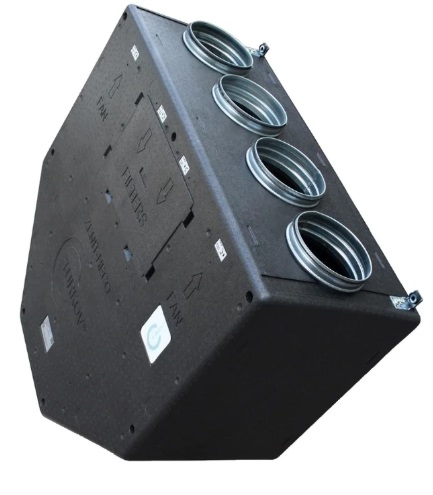
Air handling unit with recuperator and electric heater, the efficiency of which is 80%. Equipped with a small high-tech enclosure, the shape of which allows it to be installed in any room. There is high-quality insulation, which provides protection against noise-producing equipment and stable operation even at extremely low temperatures (down to -350FROM). The fans have three speed settings. The device can be installed in any convenient position both inside the building and outside due to its protection from environmental influences. Suitable for use in a private house or small administrative facility. Air exchange volume is 550m3/hour. The noise level is 45 dB.
Advantages:
- automatic control;
- compact size;
- wide range of operating temperatures;
- return not only heat, but also moisture;
- no condensation;
- does not need preheating;
- mounted in any convenient position.
Disadvantages:
- heavy;
- there are no indication sensors.
Turkov ZENIT HECO-1200
Manufacturer: Turkov (Russia)
Dimensions (h / w / d): 106x130.5x725 cm
Weight - 175 kg
Average price - 365,000 rubles.
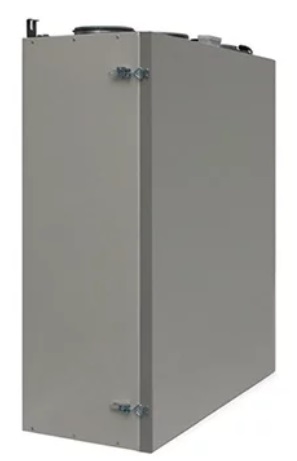
Technological air handling unit with a plate recuperator and an electric heater. It is made in an ergonomic case, the design features of which allow installation in any convenient place and position. Equipment management is simple and quick to learn. Stability of functioning is ensured even at temperatures down to -35%, so that it can be installed in cold, unheated rooms, as well as outdoors. The fan has three speeds. Supply air flow at maximum 1200 m3/hour. The recuperation efficiency is 85%. The noise level reaches 49 dB.
Advantages:
- automatic control;
- high performance;
- compactness;
- no condensation;
- work without preheating;
- good protection class (IP54);
- installed in any position;
- simple maintenance.
Disadvantages:
- price.
Chamber
PRANA-150
Manufacturer: PRANA (Ukraine)
Module diameter - 150 mm
Mounting hole diameter - 162 mm
Weight - 4.3 kg
The average price is 30,000 rubles.
Direct-flow ventilation unit with recuperation function. The body is made of food-grade plastic, the heat exchanger is copper. The device allows you to remove polluted air from the room, while supplying fresh and clean air from the street. The supply and exhaust processes are carried out through different channels, and therefore do not mix. Interchannel heat transfer takes place, that is, the air from the room gives up its thermal energy to the cold street flow. Equipment performance during recuperation: per inflow - 105 m3/ hour, for exhaust - 97 m3/hour. Recommended for servicing premises up to 60 m2... Depending on the operating mode, it consumes from 4 W / h to 17 W / h. Control is carried out by remote control or dimer.
Advantages:
- compact dimensions;
- light weight;
- high efficiency (up to 95%);
- low noise level (14 dB at a distance of 3 m);
- low power consumption;
- with the "night" mode;
- with mini-heating function.
Disadvantages:
- small performance.
Soler & Palau Respiro 150
Manufacturer: Soler & Palau (Spain)
Type: reversible ventilator
Dimensions (w / h / d): 2.15x2.15x8 cm
Weight - 3 kg
The average price is 31,000 rubles.
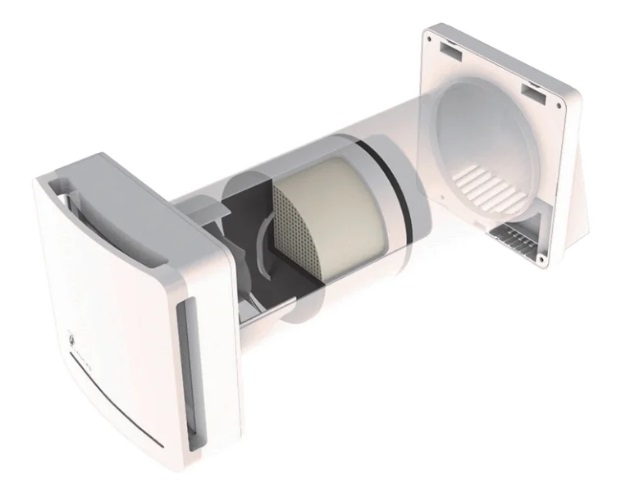
Supply and exhaust wall unit with ceramic heat exchanger for closed rooms. The permissible wall thickness is from 250 to 400 mm. Productivity is 30-60 m3/hour. Power consumption is 8.9 watts. The achievable noise level is 23 dB. The device provides a constant supply of fresh air with the removal of already exhausted air from the room. In this case, the supply medium is heated by the removed one.The device is supplemented with the function of automatic regulation of the operating speed taking into account the present humidity. It can be installed anywhere, while the equipment will not spoil the existing design and will fit into any modern interior. Working temperatures from -20 to +50 0FROM.
Advantages:
- compact size;
- with filters at the inlet-outlet;
- manual control;
- the fan operates in two speed modes;
- does not make noise;
- high recovery efficiency (up to 93%).
Disadvantages:
- low productivity.
VAKIO Base Plus
Manufacturer: VAKIO (Russia)
Pipe diameter: 125 mm
Dimensions (w / h / d): 23.4x50.5x9.8 cm
Weight - 7 kg
Average price - 19,900 rubles.
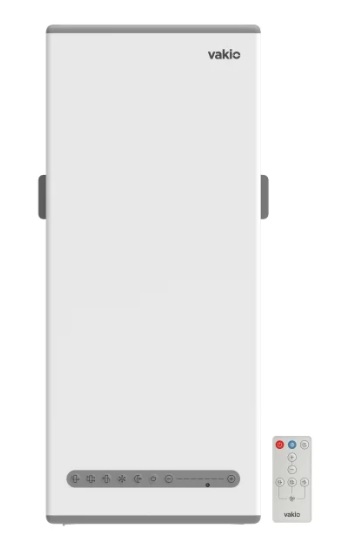
Suspended air handling unit with recuperator. Provides for wall mounting in any convenient position - vertical or horizontal. The heat exchanger is made of polyurethane and functions independently of the exhaust system. The body is equipped with an integrated control panel, thanks to which the interaction with the device is as simple and clear as possible. The filters with which the device is equipped capture pollen, fine dust, fungal spores and more. The maximum air exchange volume is 40m3/ hour, minimum - 120 m3/hour. Level - 20 dB. Works in a wide temperature range - from -47 to +500FROM.
Advantages:
- compact size;
- hidden connection;
- with a coarse and fine filter for the supply;
- remote control;
- silent work;
- warranty service in the service center;
- recovery efficiency 80%;
- economical power consumption;
- does not let noise from the street.
Disadvantages:
- requires a separate space.
If you have experience in using household recuperators described in the rating or a more interesting model, tell us about it in the comments.













Guys, can you please tell me if it is worth buying a Turkish PVA for an apartment, are the installations reliable?